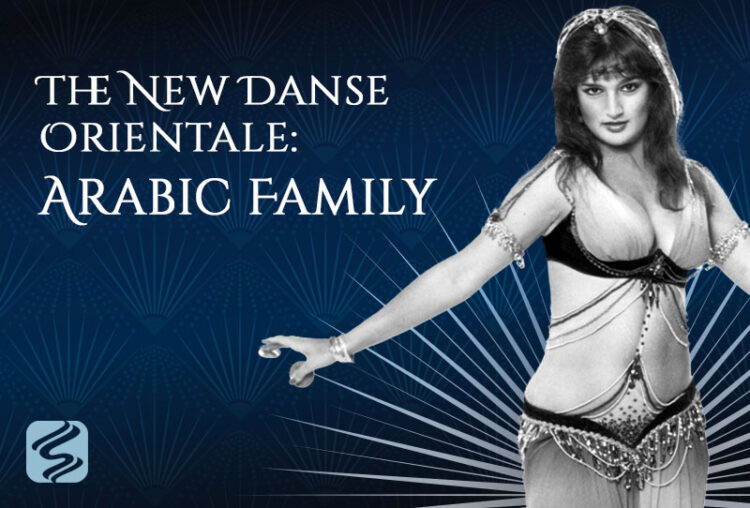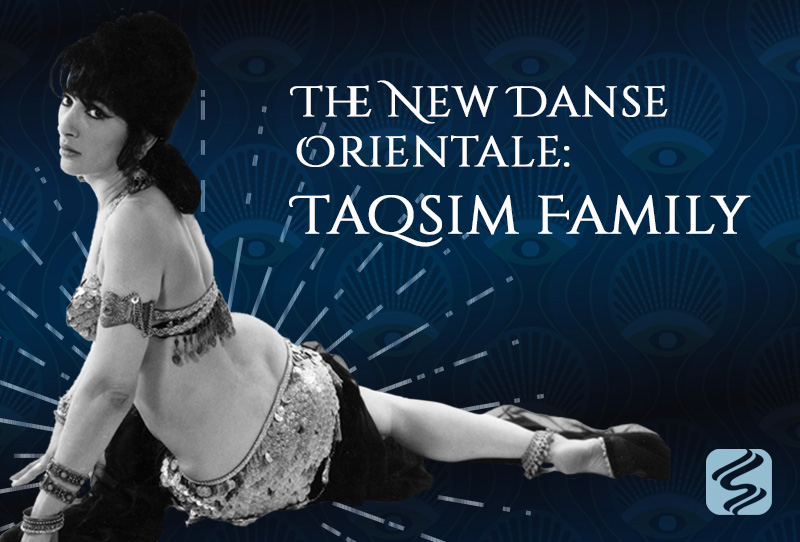Arabic Family Introduction
The Arabic family of moves is based on Jamila’s research and observations of Middle Eastern women dancing in their homes or at social gatherings. Derived from the people, these moves are considered traditional. The women that Jamila observed danced conservatively and demurely, and these moves reflect that sentiment. The typical hand positioning places one hand behind the head or at the eyebrow with the other hand either at the hip or extended through modified second.
These moves have default timings, downbeats, layering, directions, and sentiments. However, they can be varied. The key is to know the base move and to maintain the integrity of the footwork and Home Position.
Naming the Arabic Family
“Arabic” in this step family refers to the music used, as Arabic music is popular for dancing across the Middle East. Middle Easterners from various countries and regions would gather together for house parties to dance to Arabic classics and to the latest songs featured in Egyptian movies.
The Arabic Family steps are less sophisticated than the Basic Egyptian family steps. The Basic Egyptian family steps were performed by professional dancers. Therefore as part of their presentation, those dancers added more movement, drama, and shaking to the dance. Because of this, these women were deemed by culture as having questionable morals.
To prevent any association with professional dancers, regular women were encouraged to dance conservatively and modestly. Accordingly, they kept their legs together and did not shake much. The shuffling or scuffing footwork (as described in the Stylization below) was part of the subdued dancing. The women tended to have a soft and shy nature to their dancing with subtle flirting with their fellow women. Women danced together to bond their connections and community.
Stylization of Steps in the Arabic Family
- For the Arabic step family, keep the feet close to the ground. When lifting and placing feet, just barely lift the feet to give the appearance of shuffling or scuffling along the floor. Deliberately place the feet without stomping. The foot patterns are small, working through and within jazz 3rd position.
- For those steps in which one foot is tucked behind the other, push off the back foot to travel forward.
- Foot placement is essential for the Arabic step family, so despite the direction traveled or any added layering, maintain the exact foot positions.

Arabic 1
Jamila’s original term for Arabic 1 was Arabic Basic. Following, her names for Arabic 2, 3, 4 were Arabic 2nd Transition, Arabic 3rd Transition, and Arabic 4th Transition.
Definition
With right foot flat; left foot on ball tucked behind right foot. Travel forward (flat-ball- flat-ball) fulltime downbeat right. Undulation up- to-down fulltime downbeat upper back.
Notes
- Do not press your hips forward or rock your pelvis.
- The undulation is from-the-waist-up; do not contract the lower back. The lower body (hips and derriere) aren’t part of the undulating movement. As such, lower body movement would be too aggressive for the demure vibe of this step.
- The footwork does not have a bounce. The push or motion comes from the ball of the left foot.
Arabic 2
Arabic 1, 2, and 3 have a gradual build or progression with Arabic 1 as the shyest and Arabic 3 as the most flirtatious. However, all three are still demure and modest steps.
Darius (known as Chip or Chipper) was one of the original Bal Anat tray dancers. He was known for his syncopated variation of the Arabic 2 that he used for his tray dance.
Definition
Arabic 1 with flat-ball-ball-ball.
Arabic 3
Arabic 3 is featured in Suhaila’s Elf Leyla Wa Leyla choreography. When the music changes to a 6/8, Arabic 3 is combined in a sequence with a Zenouba variation and Suhaila format interior hip circles.
While Bal Anat is well known for its male tray dancers, the first tray soloist was Meta, a woman. Arabic 3 was also a theme step of the original Bal Anat tray dance in which a dancer balanced a tray throughout the performance including during floorwork. Later, inspired by a Time-Life Moroccan cookbook featuring male dancers, Jamila was the first to introduce the male Moroccan tray dance to the United States.
Definition
Arabic 2 with half figure eight back-to-front fulltime downbeat right [2&, 4&].
Notes
- For the figure eight, the front leg turns out to 3 o’clock to allow hip to move safely from 6 to 12 o’clock to protect the knee. At the end of the rotation, the foot returns to parallel.
- Step one foot at a time without stepping to the side. Keep the legs together.
- Depending on hip flexibility, your foot might turn in slightly at front to complete full hip movement.
- Jamila observed some dancers hold their left hand at their mouth with the right hand at their hip.
- Control the movement, staying level throughout without bouncing.
Arabic 4
Jamila considered Arabic 4 to be the bridge to hipwork. To emphasize this point, she included the Eight Count in the Arabic family flow. She felt the Arabic 4 transitioned well into the Eight Count. In fact, the original name of Arabic 4 was Arabic 4th Transitions Rhumba. This reflected the usage of this step by the great dancers of the 40s to the rhumba that had become more prevalent in Middle Eastern music.
Definition
Walk forward-and-back-and flat fulltime downbeat right with alternating glute singles fulltime downbeat right. Working through and within jazz 3rd position: step right foot forward [1], step left foot in place [(1)&], step right foot back [2], step left foot in place [(2)&].
Notes
- Add a little emphasis on right foot placement to highlight the movement of the right foot as it steps forward and back of the left for a common Jamila stylization.
- Keep the spirit of the step family by maintaining more of a shuffle effect to the feet.
- Arabic 4, Persian 4, and Khaleegi 4 have the same footwork, although the timings, hipwork and family stylizations are different.
Tunisian
Jamila documented this step from the dancers from Tunisian whom she danced professionally and also at home parties. The step shares some similarities to Arabic 1 and has the same demure sentiment as the other Arabic family steps. The Tunisian was used as the opening step for the Tunisian dance in the original Bal Anat which featured Ghanima. She was accompanied on the tabla baladi by her husband. Ghanima and her husband spent time in Tunisia studying the culture and traditional dance.
Definition
Alternating chasses in relevé fulltime downbeat right with undulations up-to-down fulltime upper back. Arms are held in front of the body with bent elbows at the waist level with wrists flexed and palms facing front with a relaxed hand. The ribcage moves in opposition to the feet and arms, creating a feeling of the lower and upper body crossing each other on each chasse. As the right foot leads the chasse, the ribcage angles slightly to face the front-left while the arms sway or swish to the right with a slight press forward of the right shoulder as you slightly lean your head to the right and look to the right diagonal; reverse with the left food leading the chasse.
Eight Count
The Eight Count might seem better categorized in the Shimmy Family as it is a step with prominent hipwork. Jamila placed it in the Arabic Family as the Eight Count is a good progression from the Arabic 4, which she considered the bridge to hipwork.
Definition
Upper body faces front with arms in 2nd position. Alternating singles fulltime downbeat right as you rotate feet and lower body CW flat- footed fulltime downbeat right: begin with right foot placed at 12 o’clock (pointing to 11 o’clock) and right hip at 12 o’clock; end with left placed at 12 o’clock (pointing to 3 o’clock) and right hip at 6 o’clock [1-3&]. Step on right foot in relevé at 6 o’clock (pointing to 1 o’clock) to turn CCW [4], ending flat on left foot at 6 o’clock (pointing to 9 o’clock) [(4)&].
Notes
- While your lower body rotation is featured, keep your upper body relaxed and facing forward. Initially, the imagery of keeping the upper body locked into place as the lower body rotates can be helpful. However, the objective is to have a relaxed upper body without tension.
- Do not rush the turn. The turn [7] is in relevé, but keep the feet parallel. This is not a cross turn.
- Eight Count with Quarter (or Half) Turns: starting front, use the turn on relevé to turn one quarter (or half) CCW, etc.
- The glute contractions at 12:00cf [1] and 6:00cf [6] are often accented, representing the start and end of the primary arc that defines the step pattern.
The content from this post is excerpted from The New Danse Orientale: Salimpour Belly Dance Instruction, published by Suhaila International in 2013 with updates and additional content added in 2023. The New Danse Orientale is a study guide and resource for belly dancers when learning Salimpour Vocabulary steps and step families.
If you would like to make a citation for this article, we suggest the following format: Salimpour, J. & Salimpour, S. (2023). Arabic Family. Retrieved –insert retrieval date–, from https://suhaila.com/arabic-family



